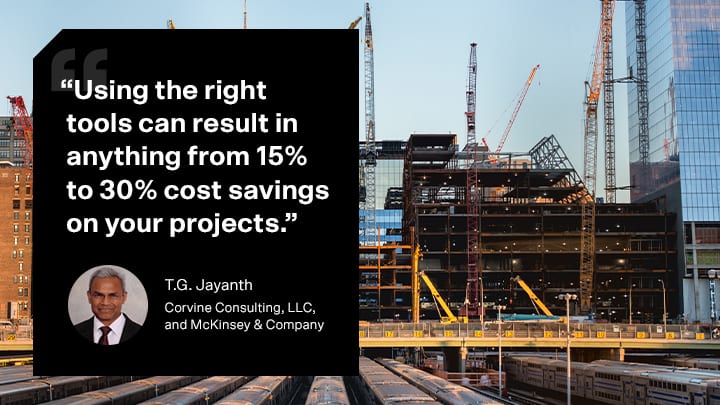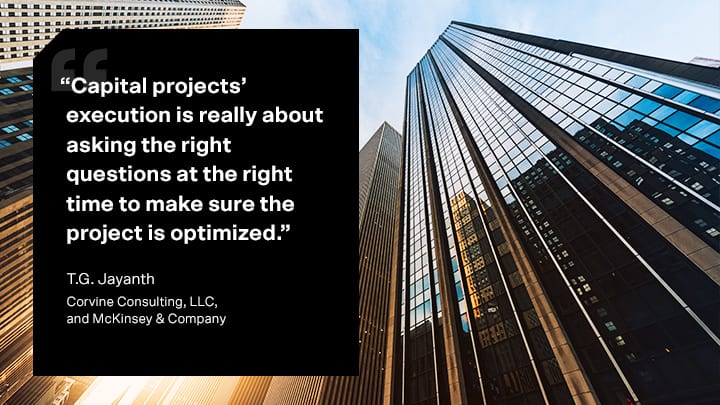T.G. Jayanth—Principal of Corvine Consulting, LLC, and External Advisor of Capital Projects at McKinsey & Company—recently spoke to a gathered group of Procore customers on the subject of “Capital Projects During a Crisis.” The crisis in question is the COVID-19 pandemic, and the effect it is having on global productivity.
Jayanth knows what’s at stake for capital project management—and sees the slowdown as a counter-intuitive golden opportunity. He invokes one of history’s notable crisis managers.
“Winston Churchill said, ‘Never let a good crisis go to waste.’ Yes, we are in this crisis. What can we do to turn this to our advantage? How can we make some lemonade out of these lemons?”
An Energizing Pause
The pandemic has dramatically put its stamp on business. Companies are temporarily (and otherwise) closing their brick-and-mortar offices, supply chains are being broken, and “disruption” is no longer just an abstract marketing term.
As medical experts and virologists throw their weight behind development of a vaccine, capital industrial construction projects—community-serving builds which rely on gathering workers in a physical, collaborative space—have been idled. Meanwhile, the capital project’s owner watches helplessly as precious minutes, hours, days and weeks become tumbleweeds rolling through a productivity gulch of expensive downtime.
Using the Downtime for Meaningful Front-End Development
There are things we can be doing even under these circumstances, but even more importantly, there are things that we should be doing. While no one knows what the future will look like, if the world returns to anything resembling the past, it’ll be a fraught, highly competitive marketplace. Demand for all resources, equipment, and good construction project managers is likely to be very high.
When the capital projects clock starts again, time will be of the essence. The spoils will go to those who have laid the best groundwork while waiting for this restart. The more prepared you are to launch your projects and construction plan quickly and effectively, the better off you are going to be. Using this time to get ready for that busy time is absolutely critical.
One initiative that many project owners could focus on during this stop-time is improving their front-end project development.
Conceive, Define, Develop: Readying the Project for Launch
While front-end planning comprises only a fraction of the total project cost—typically only five or six percent—this small initial spend, if properly invested, can blossom into repeatable high-value success. A study done by the World Bank showed there was an 86% satisfaction rate for projects that had a strong front-end project development effort—compared to a 35% satisfaction rate for those that lacked one.” Satisfaction rate is one thing. Cost savings is another.
“Using the right tools to tweak your front-end project development can result in anything from 15% to 30% cost savings on your projects,” says Jayanth.

Three Solid Reasons for Front-End Development
There are three principal reasons for thorough front-end project development.
“The number one purpose is to eliminate very quickly those projects that should not really be done,” explains Jayanth. “If you do a real postmortem on your failed projects over time, the question that you keep asking is, ‘how did this project ever get approved?’ A good front-end process would have stopped that from happening.”
Stopping imperfect and resource-consuming construction planning before it leaves the gate would certainly pay back the effort.
“The second reason,” Jayanth continues, “is you optimize the scope. Value engineering will assure that the right choices are made in terms of technology, material, equipment, and contracting. You’ll do a very detailed risk analysis.”
“The third reason,” Jayanth concludes, “is that the front-end project development process ensures that you’ve put in the right amount of effort in terms of engineering, procurement, construction input, and so on, to get to the right cost and schedule accuracy levels—and that you have done a detailed analysis of the relevant risks. You can then confidently take it to your board of directors or upper management and say, ‘Here is the probabilistic distribution of what we think the project is going to come out at.’”
Taking this time to thoroughly examine the project’s front end is crucial.
“You’ll make sure,” Jayanth says, “that everything that can possibly be done to optimize the project’s scope, technology, site selection, logistics—all those questions are asked at the right time to make sure the project is optimized.”
There are several initiatives within the broad area of front-end planning and development that owner teams could work on. They include, portfolio optimization, business case validation, stage-gate process, Value Engineering, risk management, cost estimating and scheduling, procurement and contracting, engineering and construction excellence.

The following examples—stage-gate process and project staffing strategy—are discussed in more detail to provide an idea of the work involved.
The Stage-Gate Process – Prepping for Success in Phases
A Stage-Gate process is a front-end planning (FEP) technique that effectively divides the project development into distinct stages—each planning stage ending with a decision point based on that stage’s collected data. Breaking up the FEP this way provides discreet stop-and-review points—and serial opportunities to responsibly call off unpromising project buildings before it gets started. Significantly, the Stage-Gate has to suit your proposed project if you hope to get actionable answers.
The Stage-Gate process cannot be a rigid one-size-fits-all. As an owner you’ll have large projects in the hundreds of millions of dollars. There may be plant projects which are smaller, perhaps replacement of equipment or replacement of a production line—and then there are mid-size projects, which may be expansions, modifications, or renovations. The stage-gate process has to be able to accommodate all these various projects.
The scope of the project has bearing on the number of decision stages. Here Jayanth offers rule-of-thumb specifics:
”The stage-gate process that you come up with should, for example, have three gates for the large projects, two gates for a midsize project, one for a smaller project. The flexibility should be built in.”
Front-End Gatekeepers and Approvers: Establishing a Structure
While the Stage-Gate process must flex to accommodate the planned project in question, the deliverables associated with each stage have to be clearly defined. What does the project team have to present? What level of accuracy is needed? How much engineering is needed? What kind of coach should you get? For a stage-gate process to work well, you must clearly identify who the gatekeepers are, how the materials should be presented during the gate reviews, how often you meet, and who approves what. The delegation of authority approval levels must be clearly defined.
FEP initiatives each have their proper insertion points in the Stage-Gate process. Peer reviews should happen just ahead of the gate reviews, as should the value engineering. It is much easier for the projects to be reviewed and approved when the value engineering has been expertly examined.
Project Staffing Strategy
Every initiative related to front-end planning will require action in three areas: People, Process, and Technology (or Tools). Project Staffing involves the development of a staffing strategy specific to the capital projects organization. A key decision to make is whether you should have a Project Management Office (PMO) or a Capital Projects Center of Excellence (CoE). In general, the larger the business and the more numerous the business units, the more critical it is to have a central CoE, specifically for capital projects.
Another important decision is that of creating a dedicated team to handle front-end project development. A dedicated team is in fact a highly effective way to optimize front-end planning. Specialized team members with commercial and financial backgrounds are critical to planning during this phase. The Project Manager, Construction Manager, Engineering Manager and Procurement Manager are also integral to this team, ensuring continuity and accountability through the actual project execution phase.
Who should make up the project teams? Which roles should be filled by direct resources, and which may be filled by contract resources? Other important issues include ensuring the independence of project controls’ resources within project teams. Will capital projects leadership work closely with human-resources in hiring, development, and retention plans? Are there clear and attractive career-paths for all, and programs for high-potentials?
Front-End Gatekeepers and Approvers: Establishing a Structure
While the Stage-Gate process must flex to accommodate the planned project in question, the deliverables associated with each stage have to be clearly defined. What does the project team have to present? What level of accuracy is needed? How much engineering is needed? What kind of coach should you get? For a stage-gate process to work well, you must clearly identify who the gatekeepers are, how the materials should be presented during the gate reviews, how often you meet, and who approves what. The delegation of authority approval levels must be clearly defined.
FEP initiatives each have their proper insertion points in the Stage-Gate process. Peer reviews should happen just ahead of the gate reviews, as should the value engineering. It is much easier for the projects to be reviewed and approved when the value engineering has been expertly examined.
Project Staffing Strategy
Every initiative related to front-end planning will require action in three areas: People, Process, and Technology (or Tools). Project Staffing involves the development of a staffing strategy specific to the capital projects organization. A key decision to make is whether you should have a Project Management Office (PMO) or a Capital Projects Center of Excellence (CoE). In general, the larger the business and the more numerous the business units, the more critical it is to have a central CoE, specifically for capital projects.
Another important decision is that of creating a dedicated team to handle front-end project development. A dedicated team is in fact a highly effective way to optimize front-end planning. Specialized team members with commercial and financial backgrounds are critical to planning during this phase. The Project Manager, Construction Manager, Engineering Manager and Procurement Manager are also integral to this team, ensuring continuity and accountability through the actual project execution phase.
Who should make up the project teams? Which roles should be filled by direct resources, and which may be filled by contract resources? Other important issues include ensuring the independence of project controls’ resources within project teams. Will capital projects leadership work closely with human-resources in hiring, development, and retention plans? Are there clear and attractive career-paths for all, and programs for high-potentials?

Digital Technology and Front End Planning
Stage-Gate is the framework for front-end planning—a highly structured stream of interrelated details and decision-points. Are paper and pencil going to do the process justice? A technology platform to track projects as they go through the stage gates—to gather approvals, record deliverables as they’re presented, to capture lessons learned—is absolutely critical. When you’re looking at digital technology to implement, it’s important to think of that investment in terms of how it can be used during the stage-gate process as well.
There is a lot to think about—and thanks to COVID-19, lots of time to think about it. One can panic about languishing capital projects, or seize this extremely rare opportunity for Stage-Gated introspection and precedent-setting risk management.
“We are at a point where we have some time,” Jayanth says. “We can use the time very, very effectively to improve.” He smiles. “Capital projects’ execution is really about asking the right questions at the right time to make sure the project is optimized.”
Leave a Reply